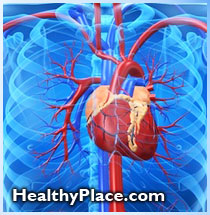The Identification and Management of Patients with a High Risk for Cardiac Arrhythmias During Modified ECT
J CLIN PSYCHIATRY 43 4
April 1982
JOAN P GERRING. M.D. and HELEN M SHIELDS. M D
Abstract
The authors describe the cardiovascular complications of ECT in 42 patients undergoing this procedure during a one year period at a psychiatric referral center. Twenty-eight percent of the entire group of patients developed ischemic and/or arrhythmic complications following ECT. Seventy percent of the patients who had a history, physical or EKG evidence of cardiac disease developed cardiac complications. On the basis of this data, a high risk category for ECT is defined more precisely than previously. Recommendations are made for managing this high risk category of depressed patients In order to treat them with maximum safety and effectiveness. (J Clin Psychiatry 43:140-143. 1982)
A mortality rate of less than 1% has been consistently reported for patients undergoing electroconvulsive therapy (ECT), the most common side effect being memory impairment. Fortunately this is usually a short term loss which may be minimized with the use of unilateral ECT. With the addition of a muscle relaxant to modify ECT, fractures are no longer the second most common complication. Rather cardiovascular complications have taken this place. In this study we define a psychiatric population with high medical risk to develop cardiovascular complications of varying severity. We emphasize the identification and special care of this group.
Method
 The charts of the 42 patients who had undergone a course of electroconvulsive therapy at Payne Whitney Clinic (PWC) during the period July 1, 1975 to July 1, 1976 were reviewed. Five patients had undergone two separate courses of ECT during this time period.
The charts of the 42 patients who had undergone a course of electroconvulsive therapy at Payne Whitney Clinic (PWC) during the period July 1, 1975 to July 1, 1976 were reviewed. Five patients had undergone two separate courses of ECT during this time period.
During the year July 1975 to July 1976, 924 patients were admitted to PWC. There were 347 males and 577 females: 42 patients or 4.5% received ECT. The average age of the ten men receiving ECT was 51 years and the average age of the 32 women receiving ECT was 54.7 years. Thirty-three patients (78%) of the group were diagnosed as having an affective disorder. These patients had an average age of 59.4 years and received an average of seven treatments. Seven patients (16%) were diagnosed as schizophrenic. These patients were much younger on the average than the preceding group (29.4 years) and had twice as many treatments per patient.
Seventeen of our patients (40%) presented with cardiac disease. This group included all patients with a history of angina, myocardial infarction, congestive heart failure, abnormal electrocardiogram, hypertension. (Table l)
The standard preparation for ECT during the year July 1, 1975 to July 1, 1976 consisted of a physical examination, hematocrit, hemoglobin and white count, urinalysis, chest x-ray, skull x-ray, lateral spine x-rays, electrocardiogram and electroencephalogram. Medical clearance, if any value was abnormal or the history revealed significant medical problems, was obtained from an internist, cardiologist, or neurologist.
Psychotropic medications were discontinued on the day prior to the first treatment and the patient was fasted overnight. One-half hour prior to a treatment 0.6 mg atropine sulfate was injected intramuscularly. First and second year psychiatric residents were in attendance in the ECT suite. After application of electrodes, the patient was anesthetized with intravenous thiopental, with a mean amount of 155 mg and a range of 100 to 500 mg. Intravenous succinylcholine, with a mean of 44 mg and a range of 40 to 120 mg was used for muscle relaxation. Mask ventilation with 100% oxygen was then begun continuing until the point in treatment when the effects of the succinylcholine were wearing off and the patient could resume breathing without assistance. This usually occurred about five to ten minutes after the dose. Patients with pulmonary disease were to have a baseline set of blood gases, carbon dioxide retainers not being hyperventilated. The modified grand mal convulsion was induced by an electric current that varied from l30 to 170 volts given over a period of 0.4 to 1 second (Medcraft Unit Model 324). In ten of 17 patients with history, physical or EKG evidence of cardiovascular disease, a cardiac monitor or twelve lead EKG machine was used to monitor their rhythm immediately before, during and for a 10-15 minute period following an ECT treatment.
The average systolic blood pressure on admission in the group who did not experience cardiovascular complications was 129 ± 21 mm Hg. The average of the highest systolic blood pressures recorded after the first ECT in this group was 173 ± 40mm Hg. A multivariate analysis was performed on the baseline blood pressure for each patient as recorded on his/her initial physical examination, as well as the highest blood pressure noted after each of the first four ECT treatments (unless the patient had less than four treatments). The systolic and diastolic pressure rise after each of the treatments were separately compared to the baseline blood pressure.
The treatment course for depression consisted of from five to 12 treatments given as three treatments per week. For the treatment of schizophrenic illness, the treatment plan consisted of five treatments per week to a total of 15 to 20 treatments.
Results
During July 1, 1975 to July 1, 1976. 12 of the 42 patients (28%) who underwent modified ECT at the New York Hospital developed an arrhythmia or ischemia following the procedure. In patients with known cardiac disease, the complication rate rose to 70%. This rate may have been even higher had all 17 cardiac patients been monitored. The four cardiac patients with no complications were not monitored so arrhythmias could easily have been missed. The 12 patients who developed cardiac complications of ECT came entirely front this group of 17 cardiac patients (Table 1) with known cardiovascular disease prior to ECT. Six of the cardiac patients had a history of hypertension, four had rheumatic heart disease, four had ischemic heart disease and three had arrhythmias or a history of arrhythmias. Sixteen of the 17 patients had an abnormal electrocardiogram prior to ECT: these included three who had a definite old myocardial infarction, two who had a possible old myocardial infarction, three other patients who had a bundle branch block, four patients with arrhythmias and four others with either left ventricular hypertrophy, left atrial abnormality or first degree heart block. Thirteen of the 17 patients were on a digitalis preparation, six were on diuretics and six were on an antiarrhythmic spent.
Four of the complications in this series were life threatening events while the rest were largely asymptomatic arrhythmias. These latter included ventricular begeminy (two patients), ventricular trigeminy (one patient), coupled premature ventricular contractions (one patient), premature ventricular contractions (four patients), atrial flutter (two patients), and atrial bigeminy (one patient) (Table 1). The complications were scattered throughout the entire treatment course and were not localized to the initial one or two treatments. Not included as a complication is the hypertensive response immediately following ECT which occurred in the majority of patients. The group of 12 patients with cardiovascular problems who developed cardiovascular complications did not have a significantly greater increase in systolic or diastolic blood pressure after any of the first four treatments as compared to all the other patients.
Arrhythmias were the most common cardiac complication. Of the nine patients who developed an arrhythmia, six had a previous history or EKG evidence of arrhythmia. Four patients developed severe complications following an ECT treatment. Patient E.S. sustained a cardiopulmonary arrest 45 minutes after her fifth treatment. She expired despite an intensive resuscitative effort. Autopsy did not reveal evidence of a recent infarction, but only evidence of an old infarct that had occurred clinically seven months previously. Patient D.S, with a history of infarction seven years prior to admission, showed electrocardiographic evidence of a subendocardial infarction after his first ECT. After transfer and treatment on the medical service, DS. completed a course of seven ECT. A.B. developed hypotension, chest pain, and premature ventricular contractions after his first treatment. In the patient M.O. rapid atrial fibrillation following the second treatment led to severe heart failure. The latter two patients were also transferred to the medical service before resumption of their ECT treatment courses.
Twenty-eight (67%) of the patients in this series were age 50 or older. Although the non-cardiac complications were evenly distributed between the younger and older patients. 100% of the cardiac complications occurred in the age group over 50 with 11 of 12 occurring over age 60. No cardiac complications occurred in the schizophrenic group all of whom were less than 50 years of age, despite the higher number of treatment courses in this group (Table 2).
Fourteen (33%) of the patients had other medical complications temporally related to ECT. The most common non-cardiac complication was a rash seen in six patients. described as urticarial or maculopapular. In two instances patients developed transient laryngospasm following ECT. None of the other non-cardiac complications would be classified as serious. Only one of the 42 patients had both a medical and cardiac complication.
Discussion
Using our review of 42 patients who underwent ECT during one year at a psychiatric referral hospital. we have identified more precisely than previously a group of patients at high risk for the development of cardiovascular complications. This group is comprised of those patients with a known history of angina, myocardial infarction, congestive heart failure, arrhythmias, rheumatic heart disease, hypertension or a baseline abnormal electrocardiogram. It is interesting that all the severe or life threatening complications occurred in patients who had previous myocardial infarctions or congestive heart failure: they appear to be a special subset of the high risk category. Since all the patients in this series with heart disease were over 50 years of age, it is impossible to say whether patients under 50 years of age with heart disease will have the same complication rate.
The cardiovascular complications in this series and in others are probably attributable to the physiological changes that accompany ECT. Autonomic nervous system activity is triggered by the electric shock. During the early phase of the seizure, parasympathetic activity predominates with a fall in pulse rate and blood pressure. This is followed by a sympathetically induced rise in pulse and blood pressure. Pulse rates of between 130 and 190 and systolic blood pressures of 200 or over are common following electric shock even in modified ECT. Atropine has been recommended for all patients undergoing ECT in order to block the excess secretions and reduce the impact of the initial parasympathetic discharge. Unfortunately. there is still a significant rate of arrhythmias subsequent to atropine as shown in our study and in others. Some of these probably result from inadequate vagal blockage and others from unblocked sympathetic stimulation. In addition. succinylcholine has a cholingeric action which may be increasingly severe with successive doses and has been shown to cause hyperkalemia.
Methohexital has been associated with fewer arrhythmias than thiopental which was the short acting barbiturate used in our patient group. Although it is not clear why arrhythmias are fewer with methohexital its use is recommended rather than thiopental for all patients undergoing ECT.
Arrhythmias were the most common complication in our series accounting for ten of the 13 complications. Except for the patient M.O. who developed severe congestive failure secondary to rapid atrial fibrillation, the arrhythmias noted after ECT in this series were benign, terminating within minutes without symptoms or signs of hypotension. congestive heart failure or ischemia. It is possible however that an arrhythmia contributed to the death of E.S.
In a recent study by Troup et al on the incidence of arrhythmias in a group of 15 patients undergoing ECT who were monitored by 24 hour Holter recordings before, during and after ECT, there was no significant difference between the number of premature atrial or ventricular contractions prior to ECT and that noted during or after ECT. The discrepancy between their findings and other reports including the present series may he accounted for by the younger age in their group of patients. The majority were in their twenties with only one patient being over 50. Of equal or greater importance may be the fact that only the one patient over 50 (age 51) had historical, physical and EKG evidence of cardiovascular disease.
In this series two patients developed ischemic complications. Other investigators have previously reported ischemic changes on the EKG during and immediately after the convulsive period. ECT induced ischemic damage is presumably mediated by the marked sympathetic stimulation as evidenced by the rise in pulse and blood pressure. The mild hypoxia, hypercapnia and respiratory acidosis which can complicate ECT may also contribute. There was no statistical correlation between the height of the systolic or diastolic blood pressure rise after ECT and the occurrence of ischemic complications. However, different susceptibilities to the rise in blood pressure may play a role in complications in a given individual.
A recent report of the task force on ECT protocol emphasized the careful tailoring of both the anesthetic agent and muscle relaxant to the individual patient based on body weight and other medications. It also stressed the use of 100% oxygen via the anesthetic mask for 2-3 minutes before injecting the anesthetic agent in patients with higher risk. On the basis of our data showing that arrhythmias and ischemic events occur more frequently in patients in the high risk category, we suggest that other precautions be taken for ECT in this group to minimize the morbidity and mortality of ECT. The additional precautions should include: 1) medical clearance from an internist or cardiologist familiar with the complications of ECT. 2) cardiac monitoring immediately preceding during and for at least a ten to 15 minute period following ECT. 3) the presence at ECT of personnel trained in cardiopulmonary resuscitation and the emergency management of arrhythmias. 4) an EKG reading before each successive treatment to establish no significant interval change and 5) frequent electrolytes particularly in patients on a diuretic or digitalis therapy throughout the ECT course.
Both suicidal and non-suicidal deaths are higher in the depressed population and ECT is effective in reducing the incidence of both types of deaths. Studies indicate that ECT is superior to tricyclics in rapidity of response and in the percentage of positive responses. ECT exposes the patient to a very short period of risk during which time he is under the direct supervision of trained personnel. In addition tricyclic use has been associated with a variety of cardiotoxicities.
Although the rate of complications for ECT is very low, those that occur most often are cardiovascular in nature. It is hoped that through early identification and management of the group of patients at high risk for these complications that the morbidity and mortality of this extremely effective treatment for severe depression will be lowered even further.
References
1. Impastato DJ. Prevention of fatalities in electroshock therapy. Dis Nerv Syst 18 (Suppl) 34-75, 1955.
2. Turek IS and Hanlon TE: The effectiveness and safety of electroconvulsive therapy (ECT). J Nerv Ment Dis 164:419-431.1977
3. Squire LR and Stance PC: Bilateral and unilateral ECU Effects on verbal and nonverbal memory. Am J Psychiatry 135:I316-1360.1978
4. Kalinowsky LB: The convulsive therapies. In: Comprehensive Textbook of Psychiatry Second Edition. Edited by Freedman AM Kaplan HI and Sadock BJ. Baltimore. The Williams and Wilkins Company. 1975
5. Huston PE: Psychotic depressive reaction. In: Comprehensive Textbook of Psychiatry Second Edition. Edited by Freedman AM. Kaplan HI and Sadock BJ. Baltimore. The Williams and Wilkins Company. 1975
6. Lewis WH Jr. Richardson J and Gahagan LH: Cardiovascular disturbances and their management in modified electrotherapy for psychiatric illness. N EngI J Med 252:1016-1020. 1955
7. Hejtmancik MR. Bankhead AJ and Herrman GR: Electrocardiographic changes following electroshock therapy in curarized patients Am Heart J 37:790-850. 1949
8. Deliyiannis S. Eliakim M and Bellet S: The electrocardiogram during electroconvulsive therapy as studied by radioelectrocardiography. Am J Cardiol 10:187-192. 1962
9. Perrin GM: Cardiovascular aspects of electric shock therapy. Acta Psychiat Neurol Scand 36 (Suppl) 152:1-45. 1961
10. Rich CL. Woodriff LA. Cadoret R. et al: Electrotherapy: The effects of atropine on EKG. Dis Nerv Syst 30:622-626. 1969
11. Bankhead AJ. Torrens JK and Harris TH. The anticipation and prevention of cardiac complications in electroconvulsive therapy. Am J Psychiatry 106:911-917. 1950
12. Stoelting RK and Peterson C: Heart rate slowing and junctional rhythm following intravenous succinylcholine with and without intramuscular atropine preanesthetic medication. Anesth Analg 54:705-709. 1975
13. Valentin N. Skovsted P and Danielsen B: Plasma potassium following suxamethoniurn and electroconvulsive therapy. Acta Anesthesiol Scand 17:197-202. 1973
14. Pitts FN Jr. Desmarias GM. Stewart W. et at.: Induction of anesthesia with methohexital and thiopental in electroconvulsive therapy. N Engl J Med 273:353-360. 1965
15. Troup PJ. Small JG. Milstein V et al: Effect of electroconvulsive therapy on cardiac rhythm, conduction and repolarization. PACE 1:172-177. 1978
16. McKenna O. Enote RP. Brooks H. et al: Cardiac arrhythmias during electroshock therapy Significance, prevention and treatment. Am J Psychiatry 127:172-175. 1970
17. American Psychiatric Association Task Force Report 14: Electroconvulsive Therapy. Washington. DC. APA. 1978
18. McAndrew J and Hauser G: Preventilation of oxygen in electroconvulsive treatment: A suggested modification of technique. Am J Psychiatry 124:251-252. 1967
19. Homherg G: The factor of hypoxemia in electroshock therapy Am J Psychiatr) 1953
20. Avery D and Winokur G Mortality) in depressed patients treated with electroconvulsive therapy and antidepressants. Arch Gen Psychiatry 33:1029-1037. 1976
21. Buck R. Drugs and the treatment of psychiatric disorders. In the Pharmacological Basis of Therapeutics (Fifth Edition) Edited by Goodman LS and Gilmar, A. New York. Macmillan Publishing Co. Inc. 1975
22. Jefferson J: A review of the cardiovascular effects and toxicity of tricyclic antidepressants. Psychosom Med 37:160-179.1975
23. Moir DC. Cornwell WB. Dingwall-Fordyce et al. Cardiotoxicity of amitriptyline. Lancet: 2:561-564. 1972
next: The Practice of Electroconvulsive Therapy
~ all Shocked! ECT articles
~ depression library articles
~ all articles on depression
APA Reference
Staff, H.
(2000, December 29). The Identification and Management of Patients with a High Risk for Cardiac Arrhythmias During Modified ECT, HealthyPlace. Retrieved
on 2025, November 25 from https://www.healthyplace.com/depression/articles/the-identification-and-management-of-patients-with-a-high-risk-for-cardiac-arrhythmias-during-modified-ect


